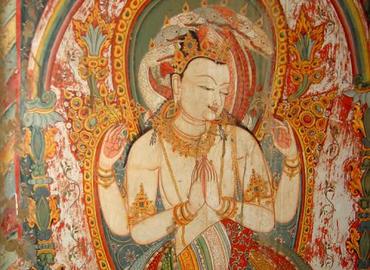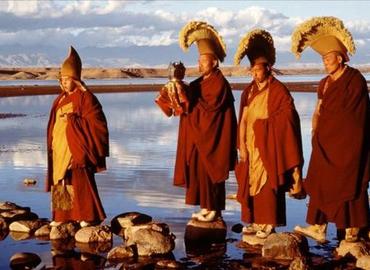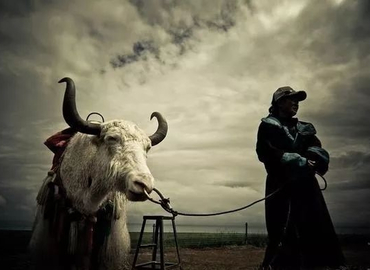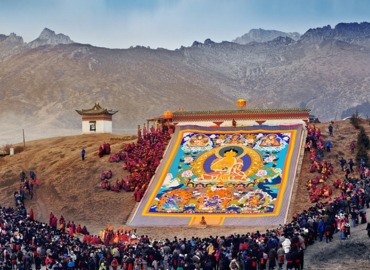8 Auspicious Symbols of Tibetan Buddhism
- Eric
- Last Updated : 04/25/2025
If you travel to Tibet, you will definitely learn much about its culture and traditions. You would also get to visit some of its outstanding monasteries and religious shrines. If you try to walk inside these famous Buddhist shrines, you can notice various artistic representations. The most famous of these aesthetic symbols are the 8 Auspicious Symbols of Buddhism. But what is the significance of these Tibetan symbols?
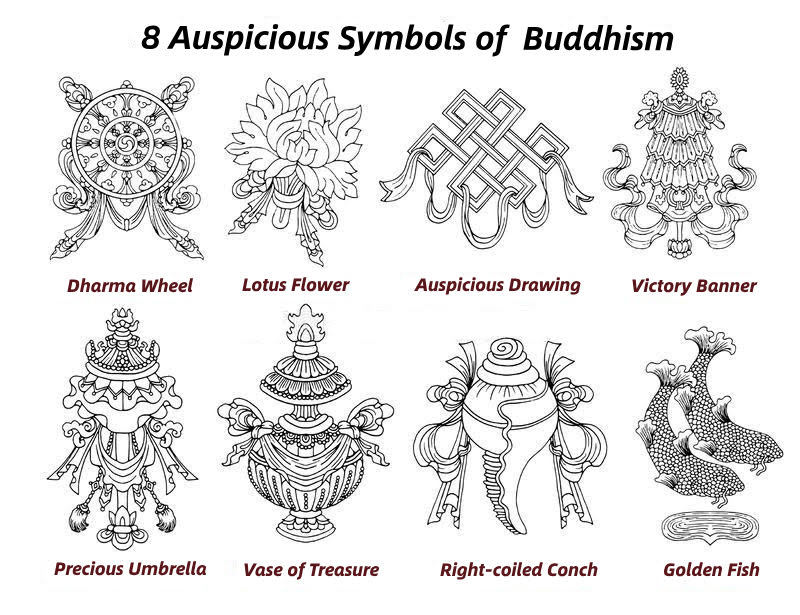
The Origin of the 8 Tibetan Buddhist Symbols
The origin of the 8 Tibetan Buddhist symbols can be traced back to ancient times, to ancient India, where Buddhism originated. Although some of these eight symbols may be associated with the ancient royal rituals in India during the coronations of kings, some of these eight symbols were slowly imbibed into Buddhism. These symbols were then adapted for local Tibetan Buddhism. Some of these symbols, however, originated from Tibet and have their own local implications. At present, the eight auspicious symbols of Buddhism are closely related to the Buddha or Dharma. These symbols of Buddhism represent the offerings that were made to Buddha by the gods when he achieved enlightenment.
What Do the 8 Auspicious Symbols of Tibetan Buddhism Imply?
You may be surprised as to why these 8 symbols are called “auspicious”? They are called “auspicious” because they are symbols that are conducive to success. Hence, these 8 symbols are often seen on many holy altars in front of the Buddha and on murals. There are also a few carved and three-dimensional shapes.
These 8 symbols of Buddhism often serve as the focal points of meditation and contemplation. Westerners may not understand the implications of these symbols. But for those believers, these symbols have something to do with future success, spiritual victories, and favorable happenings in the future. So, if you want a better future or if you want to grow deeper in your spirituality, it will be good to make these symbols your focus in your medication and contemplation. Here are the 8 auspicious symbols of Tibetan Buddhism and their meanings:
The Eternal or Endless Knot
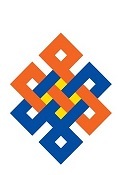
The Eternal Knot is explicative of cause and effect. It also represents interactions. This symbol is characterized by entwined lines in a closed pattern. This enclosed pattern signifies the interrelationship of all happenings or phenomena in this world. It also implies the mutual dependence of secular life and religious doctrines. As a symbol of cause and effect, it signifies that whatever happens or occurs because something produces it and that events have interrelationships. If you clearly understand the implications of this symbol, you will become wise and enlightened in life.
The Eternal Knot symbolizes the mind of the Buddha. It epitomizes his eternal wisdom as well as his endless compassion. As a symbol that represents Buddha's teachings, it shows the twelve links and the continuity of interdependent origination. These twelve links of interdependent origination, in turn, trigger the cyclic existence of reality. In its general sense, it depicts the real nature of this world that everything in this world is interrelated. Each exists only as an integral part of the web of karma and its inevitable effects.
The Treasure Vase
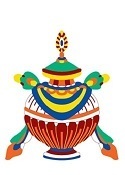
The Treasure Vase is a representation of long life and prosperity. This symbol is represented by the traditional Indian water pot that is made of clay. This clay water pot is called “Kalasha.” In India, this sacred pot is venerated, especially, in the Kumbh Mela's Pot Festival. It signifies that even if you take things out of the treasure vase, you will still get offerings out of it.
The Treasure Vase also represents prosperity and wealth. It is also explicative of all the inexhaustible benefits that you can get when you attain enlightenment. Since it is a divine vase of treasure, it is perpetually full. This means that if you aspire for enlightenment, you will be perpetually filled with treasures that do not corrode and fade.
The Lotus Flower
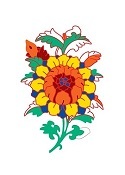
The Lotus Flower is a great auspicious symbol whose meaning everyone should comprehend. The Lotus Flower begins to grow at the very roots of the lotus plant, which is usually submerged in the mud. Then, it slowly rises out of the mud or the muddy water as an awesome flower that is worth looking at. How it grows provides us with a great lesson in life. Behind its tantalizing beauty lies those struggling to rise above the difficulties and hardships of life. Thus, it gives us a valuable lesson that we should never be bogged down by difficulties and hardships. Instead, we should rise above those trials in order to blossom into a fully-grown and wonderful person.
In a way, the Lotus Flower in Buddhism signifies purity and renunciation. It is the epitome of how a person can attain full spiritual blossoming through trials and difficulties. It also signifies a complete break from the cyclic existence or karma that usually besets a person. In many Buddhist temples and altars in Tibet, you will often see the image of the Buddha seated over a blossoming lotus flower.
The Two Golden Fish
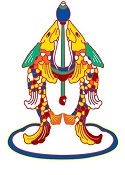
The Two Golden Fish symbolizes impulsiveness and happiness in Buddhism. It also represents complete liberty of motion or movement in the water. Moreover, it represents profusion and fertility for fish can multiply rapidly. Thus, this symbol deeply represents freedom from the shackles of status or caste. In China, this symbol represents conjugal harmony and loyalty for fish usually swim in pairs.
In Tibetan Buddhism, the sea is usually associated with the world of suffering and trials. This world of suffering is called the "cycle of samsara." The symbol of these two Golden Fish represents the contentment and courage to swim across the ocean of suffering without tiring and drowning, and free of fear and anxiety. Artists usually depict these two fish as two carp fish because the carp is an elegant fish owing to its great shape, size, and longevity.
The Parasol
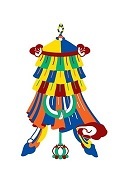
The Parasol is indicative of royal dignity. It also symbolizes protection from the sun's heat. In a way, it symbolizes protection from suffering. The parasol is usually ornate. It is depicted with a dome that represents wisdom. It also comes with a skirt around the dome that represents compassion. More often, the dome is shaped octagonally to represent the Eightfold Path of Buddhist practices. In some instances, it is shaped like a square. As a square, it represents the 4 directional quarters.
Over the domed frame of the parasol stretches yellow or white silk. A pleated silk frieze usually hangs from its circular rim. The silk frieze has multi-colored valances and silk pendants. The lower circular rim of the parasol is marked by a golden crest bar. Moreover, its silk frieze may be bedecked with yak-tail pendants and peacock feathers.
The Conch Shell
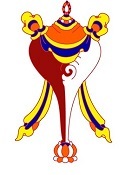
The Conch Shell symbolizes good actions because through its permeating sound it inspires the masses into good actions. Its sound awakens the masses from their ignorance and leads them into enlightenment. Since ancient times, the white conch shell that is characterized by its spiral contour to the right has been used to sound a call to action.
Traditionally, the ancient gods carried huge conch shell horns that proclaim their triumphs and valor. The conch shell has also been used as a battle horn that is similar in function to that of the contemporary bugle. Thus, the conch horn, since time immemorial, has been a symbol of power, sovereignty, and authority. Common folks believe that it could banish evil spirits, ward off harmful creatures, and prevent natural disasters.
In the early years of Buddhism, the conch shell had been used as an emblem of the sovereignty of Buddha's teachings. In fact, it symbolizes the undaunted fearlessness to proclaim the truth. In most Tibetan monasteries, the conch is presently used to call the religious assemblies together. Thus, if you visit one of the monasteries in Tibet, you will surely see the conch shell symbol. You may also hear its awesome sound.
The Victory Banner
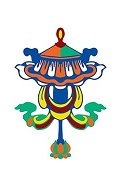
The Victory Banner is a representation of the victory of the Buddha over the four Maras. The four Maras represented the fear of death, disturbing emotions, aggravation, and seduction. The Victory Banner was gifted to the Buddha after he conquered the four Maras. In a deeper sense, it represents the triumph of wisdom over ignorance. The old legend says that after triumphing over the four Maras, the Buddha raised the banner of victory at Mt. Meru to signal his victory over all the obstacles to enlightenment.
The Dharma Wheel
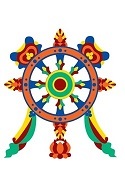
The Dharma Wheel is characterized by eight spokes. Each of these spokes represents the Eightfold Path. This Eightfold Path is considered to be the path to enlightenment. This path to enlightenment requires pure intentions and total commitment to mental discipline and ethical conduct. Buddhism, in its early years, adopted the symbol of the Dharma wheel as its primary insignia. The Dharma wheel is considered to be the "wheel of spiritual change or transformation." The rapid motion of the wheel represents the quick transformation wrought by Buddha's teachings.
The first discourse of Buddha, done at the Deer Park in Sarnath, contains the Four Noble Truths together with the Eightfold Noble Path. This episode in the life of the Buddha refers to the first turning of the Dharma's wheel. On the other hand, his other great discourses in other places like Rajgir and Shravasti represent the second and third turnings of the Dharma's Wheel successively.
The Wheel of Dharma has three major components, namely, the hub, spokes, and the rim. These three components signify integrity, wisdom, and attentiveness. These three characteristics are the three aspects of the teachings of Buddha.
Email response within 0.5~24 hours.


